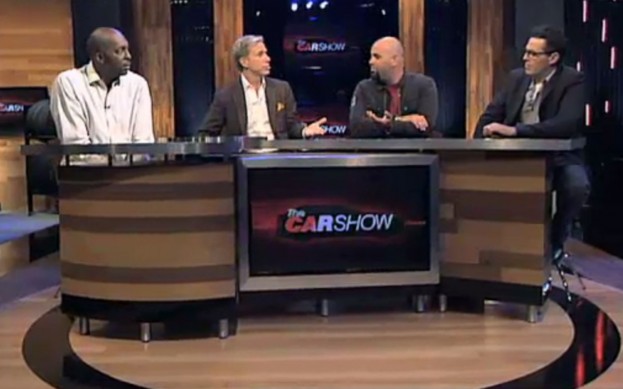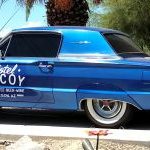The roofline looks clean and formal. It seems to take after the stylish new Kia Optima. The Kia still looks better.
Monthly Archives: July 2011
Corporate profits up. Employment levels stagnant. Greed?
Recent news stories from the last few weeks have observed a rise in corporate profits and a corresponding (or non-corresponding) lack of improvement in reported unemployment rates.

Naturally, some have expressed concern that large corporations are hoarding profits instead of spending, expanding, and hiring new workers, accusing business leaders of greed and cash hoarding. Unfortunately, this topic comes with unnecessary political baggage and finger-pointing, with so-called liberals and conservatives blaming each other for our current state of affairs.
I tend to avoid direct political references on this blog because major party- and popular ideology-oriented discussions cause otherwise rational people to retreat to shallow talking points and noisemaking. It’s like yelling “fire” in a crowded theater. The result is paranoia, panic, and screaming.
A recession’s purpose is to eliminate inefficiencies created during times of prosperity, which unfortunately means that not all jobs lost since 2008 will return as not all them were necessary (thus, inefficiencies), thus the need for personal flexibility, mobility, and retraining in a market economy.
The reality of the situation is much simpler, less emotional, and far less political.
Economic recoveries happen in stages:
1. A recession causes lower revenues and greater losses, so non-essential workers are laid off as non-essential business units are closed or sold. Layoffs are followed by profits due to greater efficiencies and a stronger focus on core products and services.
2. Profits are paralleled by growth and increased productivity which leads to…
3. …reexpansion and hiring.
This quarter (Summer 2011), we are on the tail end of step 2. Until owners of capital resources feel confident in the economy’s ability to sustain a predictable level of growth, step 3 will be delayed.
The brief gap between step 2 and step 3 is often interpreted by the layperson as corporate greed: “Why aren’t you hiring if you’re so profitable?”
I empathize with the millions of unemployed eagerly waiting to rejoin the workforce, but the accusation is a bit misguided. This is not to suggest that “greed” [for this discussion, lets accept the popular negative connotation of the word] is entirely absent from decision-making processes, however, it is not the core motivator behind top-level managerial decisions.
Before making the choice to expand and grow, a large organization’s shareholders and managers must feel confident that taking a risk will result in sustainable growth. This means that the macroeconomic outlook must be reasonably stable and predictable otherwise the business will be needlessly vulnerable. The consequences are costly — revenue losses immediately followed by additional layoffs.
In other words, forward-thinking corporations are generally motivated to hire and expand. Capital resources, especially labor, are necessary to increase market share and develop new products and services. Unfortunately, until the waves caused by this recent recession settle, expansion is on hold. Our military involvement in Iraq and Afghanistan has created an unstable geopolitical environment which has cast a cloud of uncertainty over a significant portion of the global economy. Additionally, massive government spending, rising fixed and variable costs, high energy costs, and aggressive global competition have contributed to slower levels of expansion.
Despite these uncertainties, industries that often serve as indicators of economic health, especially the auto industry, have demonstrated recent growth. Ford, Chrysler, and General Motors as well as the North American arms of Honda, Toyota, Daimler AG, BMW, Hyundai/Kia, and Nissan have been on a hiring spree, recruiting new graduates as well as longtime professionals who were laid off by the now-smaller Detroit Big Three.
Reduced employment capacity in Michigan has shifted labor demand to the Southeastern United States. Foreign automakers have opened new plants and corporate offices in that region to avoid high labor costs and expand US market share.
Although part of the industry’s explosive sales growth is due to pent-up demand caused by 2009’s “Autopocalypse” [aptly coined by Jalopnik], the automotive sector should be sustained by stronger competition, new technologies, and the public’s desire to transition to more efficient vehicles.
The recession officially ended in the summer of 2009, but after two years the global economy has failed to return to pre-recession levels of growth. Frustration is expected, but we should avoid using our emotions to draw irrational conclusions about the macroeconomic environment.
There are indeed real villains who have contributed heavily to this recession. Unethical greed backed by government-supported growth bubbles have had a severely negative impact on economic stability. But the recovery, while slow, is indeed progressing. Focus on yourself professionally to be better-prepared for an economic upturn.
Good times are ahead. Have a chocolate milk.

http://www.usatoday.com/money/perfi/stocks/2011-07-10-earnings-season-starts_n.htm
http://www.huffingtonpost.com/grant-cardone/economic-recovery-stages_b_234134.html
Reader Travel Photo: Veedub at Sequoia National Park, 10,000-Mile Road Trip
On Facebook and Twitter, I made an offer to send a crappy prize to a reader that sent an interesting travel and/or car photo. Kathleen from Chicago submitted this picture of her 2000 Beetle GLS parked at Sequoia National Park in California.

—————————————————————
Here’s the story behind the picture in her own words:
Here’s my travel photo submission:
I bought my first brand new car in November 1999… a 2000 Beetle GLS. A month later I was offered a short term assignment to work in Prague. After that I went to NYC for 18 months, and then London for 2 years. I returned to Chicago in April 2004, where my Beetle had been lovingly stored and cared for by my father for 4 years. She had less than 10,000 miles on the odometer.
After I was laid off a month later, I took off on a 2 month road trip where I visited numerous national parks and saw a baseball game in every major league ballpark west of the Mississippi River.
I drove 9,775.2 miles, used 358.889 gallons of gas, got 27.24 MPG, and paid an average $2.02 per gallon (I have a spreadsheet detailing every fill-up). This is a picture of Beetle in Sequoia National Park in CA. I held up traffic to take it, but one guy called out “that’s gonna be a cool picture”.
I am attaching details of the infamous summer of 2004 baseball trip in the Beetle. I have not looked at this file since late 2004, and it is really scary how meticulous I was with tracking this trip. I guess when you are an unemployed accountant, you must have some outlet.
My Audi (2009 Audi A4 Sedan 2.0 T quattro Tiptronic) became my everyday vehicle upon its purchase in November 2008. I kept the Beetle (yes, I was a 2 car single woman) until June 2010. I figured it was a second car for anyone who needed it (my nephew JD drove it once in a while). I kept it at my parents’ and the insurance was only $215/6 months. I sold the car to my brother John for my niece Julie to drive in June 2010. She still drives it.
–Kathleen
—————————————————————
I asked Kathleen’s niece Julie, who recently adopted the Beetle, how the car was doing:
Current mileage is 71,607 (and about to get a lot more!). I like the car. It’s worked very well getting me place to place (as cars should do), but it can be a pain to maintain. There always seems to be something wrong, and sometimes fixing it myself can be a hassle. Take for instance the air filter, I needed to change it, but everything is so crammed together under the hood that it took a half hour just to get the cover off. But my favorite thing about the Beetle is making middle school kids punch each other when I drive by. 😛
–Julie
—————————————————————
Indeed, many Volkswagens of that vintage can be maintenance-intensive with design quirks that sometimes complicate basic repairs. For example, headlight bulb replacement is unusually challenging, requiring extra steps involving the removal of brackets and covers. Some Beetle owners leave this job to their Volkswagen dealer.
Some of the difficulty is due to the New Beetle’s classic round shape draped over the mechanicals of the fourth-generation Volkswagen Golf. While the box-shaped Golf was a natural fit for a front-drive, front-engined architecture, the hemispherically-inspired New Beetle took after the appearance of the rear-engined 1938 Type 1, making the fitment of components a bit unusual.
Its a bit like wearing your pants backwards. Works fine once you put them on, but getting in and out is a challenge.
That aside, the New Beetle looks sharp and drove well, racking up nearly 900,000 worldwide sales by the end of 2005, an impressive feat for a car with limited interior volume for its class. Fortunately, the rear seats fold flat to expand cargo space, making it possible for two people to load up their luggage and go on a trip.
The car’s iconic shape appealed mostly to single young women and empty nesters — a rolling tribute to youth and independence.
And although fuel costs were quite low in the late 1990s, Volkswagen offered a diesel TDI version capable of 48 MPG, and turbo gasoline models were capable running from zero to sixty in less than 7.5 seconds.
Owners frequently praise the New Beetle’s long-distance seating comfort, which brings us back to Kathleen’s road trip.
An accountant by profession, Kathleen submitted an exceptionally detailed travel log documenting every mile, every day, every location, every baseball game, every gallon of gas, and every dollar spent.
Download the Travel Log (Excel Spreadsheet)

9,770 miles were covered in two months
Fuel costs totaled $724.60
Average fuel price was $2.02 (2004)
Hotel costs totaled $3619.88 for 39 nights (see spreadsheet)

The level of accuracy and the quantity of data is impressive.
In return for submitting this exceptionally well-documented story and photo, Kathleen will be receiving a brand new Audi R8:

Audi R8 Features and Specifications:
Hand propulsion
Five-spoke plastichrome wheels
Fixed-position steering
Red metallic paint
Steel body
Plastic chassis
Manufactured in Thailand
Curb Weight: Around 40 grams
In addition, she will receive a copy of Teen Wolf and Teen Wolf Too on DVD, because Michael J. Fox is awesome and Jason Bateman is pretty darn good.
Review: “The Car Show” with Adam Carolla, First Episode
Watch the episode here:
http://www.hulu.com/the-car-show
Not bad! [And far from great.]
The dialogue was a bit dry but by the end of the episode, the foursome developed some chemistry and character distinction.
Dan Neil is the snob with brains.
Matt Farah is the gearhead critic.
Adam Carolla brings comic relief and mechanical know-how.
John Salley, a Corolla owner who thinks leather seats should be banned, represents the average American motorist.
Part 1:
Matt Farah’s commentary on the Porsche 911 GT3 was summed up by a single, moronic declaration: “It feels like driving a RACE CAR!”
Come on, really? What else did we think it was going to feel like? A Buick Lesabre?
Part 2:
The foursome participated in the 24 hours of Lemons with a 1994 Nissan 300ZX 2+2, fizzling out early when the car caught fire. They demonstrated a grasp of physical comedy but the scene was ruined by bland, lifeless background music that apparently came from a collection of royalty-free, computer-generated hard rock. It may as well have been porno music.
Part 3:
They quizzed Dan Neil and two audience members using a game show format. The trivia questions were interesting but the segment was a bust.
The interview with Nascar driver Jimmy Johnson was unexpectedly well-paced and engaging.
Part 4:
Dan Neil has grown on me — his pompous attitude reminds me of Automobile Magazine writer Jamie Kitman, known for his quality writing and obnoxious liberal views. I cringe when Kitman opines, but I admire his writing. Likewise, Dan comes across as smug, but he presents well on television.
Adam Carolla’s inappropriate comments work well with Dan Neil’s suit-and-tie professionalism, as demonstrated by the drive along Pebble Beach with Neil piloting a Rolls Royce Ghost and Carolla in the back eating fast food. The dialogue needed some work, but the sentiment of comedy was there.
The segment at the end about meter maids was too short to be interesting and too long to be funny.
I see more potential for growth and improvement on this show than I do for Top Gear USA. The hosts (well, perhaps just Neil and Carolla) are confident about their roles and the perspectives they represent, and both of them are walking tomes of automotive knowledge. The background music, however, is unfortunate, and the cinematography needs refinement.
I will continue watching.
“The Car Show” with Adam Carolla Debuts TONIGHT (July 13, 10pm)
Fast Tube by Casper
Disappointed with Top Gear USA? There’s hope.
With four hosts, The Car Show is approaching the size of a boy band:
Adam Carolla, with a reputation for dry delivery and sharp wit
The Wall Street Journal’s car columnist Dan Neil
Detroit Pistons star John Salley
Matt Farah of TheSmokingTire.com.
We know Carolla from his podcasts, his love for classic Datsuns, The Man Show, and years as co-host of Loveline.
Dan Neil has a reputation for being a bit edgy (as far as newspaper writers go), once describing a back seat sexual encounter in a review of the 1996 Ford Expedition and the children who later boarded the vehicle and noticed of the foot prints on the glass. This resulted in his termination from News and Observer.
The preview looks edgy, witty, and sharp, like Top Gear UK with American bravado. The first episode airs on Speed TV at 10pm tonight (13 July 2011). Check your cable listings.
Fast Tube by Casper
Preview clips:
http://www.speedtv.com/programs/the-car-show/the-car-show-featured-clips/
NICO Review: 2011 Nissan Murano CrossCabriolet
Nissan’s homely Murano CrossCabriolet was such a joke among enthusiasts that Car and Driver wrote its review as a Greek tragedy. Becky from NICO Club gives it a more down to earth overview, taking it for a thorough test drive.

The Good:
Smooth powertrain
Seating comfort
Interior quality
The Bad:
Ugly(!)
Wind noise
Poor visibility
Expensive
Excerpt:
“Most of the time, I’m pretty excited to be one of the first members to get to drive one; this time, not so much. When the first pictures of the Cabriolet surfaced, I honestly thought it was a joke. I thought someone was just playing around on Photoshop with a picture of a Murano. When I found out it was real, I immediately went on the defensive. “Do I really have to drive that thing? Can I wear a disguise?” Yeah, OK, that is a bit dramatic but I honestly didn’t want to drive it at all. It is not my style and probably not the style of most of the members on NICO. However, I knew that it was not up to me to decide what other people like and don’t like.”
Read the full review here.
Book Review: The Wal-Mart Effect
Book Review: The Wal-Mart Effect

My interest in Wal-Mart is primarily as a traveler, and as someone with a degree in business and an interest in economics, I’m fascinated by the company’s discipline, determination, and strict unwavering adherence to its operating principles.
Our family did quite a bit of cross-country touring in the 80s and 90s, and as a kid I had the privilege of seeing Florida, California, the Carolinas, Texas, Utah, Arizona, Branson, the Pacific Northwest, New York City, Washington DC, the Dakotas, and one visit to Thailand. We weren’t wealthy and for most of my youth I remember living below middle class standards, but we functioned well within our means and had enough set aside for sightseeing. Much of that travel was, unfortunately, in a crude and gutless Nissan Sentra (which years later became my first car).
If we were on the road in a remote part of the country or traveling late at night, fresh food and basic services were difficult to come by. Road trippers were relegated to a selection of soda, chips, and snack cakes at gas stations (assuming they were open late). And in some regions, like the Rockies and Great Plains, gas stations were sparse with unnervingly long distances between fill-ups.
By 2000, at the age of eighteen, I noticed a change in America’s landscape as I began taking long-distance journeys on my own. The remoteness and sparseness that defined interstate travel west of the Mississippi River was quietly replaced by standardized familiarity.
Wal-Mart spread itself wide, extending its reach far beyond the midwest to Mexico and Canada in the 1990s and Germany, China, Great Britain, and Japan in the 2000s. It was possible to tour the continent (and some of the world) and encounter a Wal-Mart Supercenter with “always low” prices in almost every city. If you needed something, anything at all, Wal-Mart was there.

Large blue and white fluorescent Wal-Mart signs visible from the highway drew the hungry and weary to an oasis of consumer decadence. Rather than navigating through a town’s main square where stores typically closed at 6pm and products came with a premium price, a traveler could stay close to the interstate and stop in for motor oil, extra clothing, a decent sandwich, fresh fruit, power connectors, computer parts, CDs, tires, tire plugs, gas caps, oil caps, gasoline, and anything else a traveler could ever need, all within 100,000 square feet.
If you needed automotive basics, you no longer had to stay in town overnight and wait for ‘Joe’s Parts Depot’ to open at 7am to replace your dead headlight bulbs or the gas cap you left behind several miles ago, and you weren’t stuck with the frozen hot pockets at the gas station for your evening meal. Whatever you needed, unless it was particularly exotic, Wal-Mart probably had it. There was no need to settle for limited selection, unpredictable quality, unknown brands, or high prices. With Wal-Mart Supercenters on the road, I had direct access to the same array of goods as I did at home.
So, what’s a Supercenter?
Wal-Mart Supercenters are defined by their massive floor space, usually 80,000 to 120,000 square feet, generous operating hours, usually 24/7, and combination of full-line groceries and consumer goods. Almost everything you could find on the shelf in Chicago or St Louis was readily available in Denver, Cheyenne, Salt Lake City, Tampa, Miami, or Seattle. Like the McDonald’s Big Mac, Wal-Mart had standardized and nationalized shopping. Differences are found in international regions like China, where Wal-Mart sells locally-desired fresh meats like turtle. [I like turtles.]
For me, its retail heaven. To skeptics, its a corporate monster unaware of its brutal impact, sending manufacturing jobs overseas, reducing consumer expectations for quality, killing capitalism, and homogenizing American culture.
Charles Fishman, a business writer for Fast Company magazine, began working on The Wal-Mart Effect in 2004 and published his findings in 2006, just as Wal-Mart ramped up its openings of massive 24-hour supercenters across the globe. Sam Walton had been dead since 1992.
“The Wal-Mart Effect,” abbreviated as TWME from here onward, begins with the good news first, documenting the way Wal-Mart turned Makin’ Bacon, a plastic microwaveable tray developed by one man and his eight year old daughter, into a major success story for an American entrepreneur. Makin’ Bacon was previously sold through mail-in labels on Armour bacon packages but Mr. Fleck, the designer and patent holder, convinced Wal-Mart in 1996 to carry the product in all of its stores.

Fleck, a one-man basement operation, has the same direct access to Wal-Mart’s computerized ordering system as Proctor and Gamble, and has the ability to fulfill orders at a moment’s notice. Fleck investigated Chinese manufacturing but found the quality to be inconsistent with long lead times for slow container shipments. Producing his product in Wisconsin, he says, allows him to respond quickly to changes in demand and keep the quality consistent.
To this day, the price of the Makin Bacon at $6.97 has not changed. Wal-Mart typically asks its suppliers for price concessions every year, but Fleck has been inexplicably immune. The book does hint at Wal-Mart’s tendency to prefer American-made goods, but if offshore manufacturing produce it for less with similar (though often inferior) quality, Wal-Mart may encourage suppliers to move their operations overseas to reduce costs.
Not all supplier relationships with Wal-Mart were as easygoing.

Fishman investigates Snapper, a company that builds premium lawn mowers and outdoor equipment, and their decision to pull out of Wal-Mart to protect its brand identity and create value for its customers. Wal-Mart sells mowers from $99 to $200 and asked Snapper to create a line of lower-end mowers for the store. Snapper, which prices its mowers at $299 and up (way up), decided to remove its products from Wal-Mart completely, bolstering its independent dealers (which still made up 80% of Snapper’s business) and maintaining production in the United States.
Snapper’s CEO drove directly to Bentonville, met personally with Wal-Mart, and explained why his company was removing its products.
The book touches briefly on Sam Walton’s philosophy, with his emphasis on humility and efficiency for the good of the customer, and his encouragement for and inspiration of Wal-Mart’s thousands of employees, traveling to every store and remembering as many faces as he could by name. There was no disconnect between the CEO and the front line in Walton’s Wal-Mart.
As a recipient of the Presidential Medal of Freedom, Sam Walton was an icon of entrepreneurial America, an example of how freedom and determination enabled a man from Missouri to become the wealthiest man in the world. Fishman notes a change in Wal-Mart’s character after Walton’s death in 1992, from one of American pride and openness to one of secretive, close-doored intensity.
Fishman goes on to explain how Wal-Mart plays a major role in controlling the rate of inflation (CPI) and in keeping living costs down for American families despite rapidly rising costs of energy, food, and housing.
Wal-Mart is, as described by Fishman, an advocate of the consumer, pushing for lower prices no matter what. It begins with Wal-Mart’s streamlined shipping and warehousing, all done in-house with the largest privately-owned truck fleet in America.
It follows with Wal-Mart’s intimate relationships with its suppliers, asking over and over where price concessions, efficiencies, and cost reductions could be found, sometimes reaching deep into the production process, asking firms to use cheaper overseas manufacturing.
It is easy to portray Wal-Mart has a hungry, faceless beast, devouring America’s manufacturing sector as it feeds its greed and addictive growth. However, unlike oil barons and railroad barons from a century ago, Wal-Mart continues to run a remarkably lean operation.
Shareholders, many of whom are Wal-Mart employees, referred to as “associates,” have done quite well. If you owned a hundred or so shares of WMT in the 80s, you would be a millionaire by the mid 1990s. Employees who believed and invested in Wal-Mart in its early years enjoyed rewarding and highly profitable careers.
But Wal-Mart, unlike oil barons of the distant past, doesn’t use its profits to fund lavish lifestyles, build offices with marble tile, shuttle its people around in limos, or feed its executives with Russian caviar. Instead, its Bentonville headquarters are shockingly spartan.
The company’s home office looks, as Fishman described it, like a call center for a credit card company, lined with small, plain-looking cubicles, walls and ceilings similar to a warehouse or storage unit, and carpeting out of the cheapest, thinnest grade available.
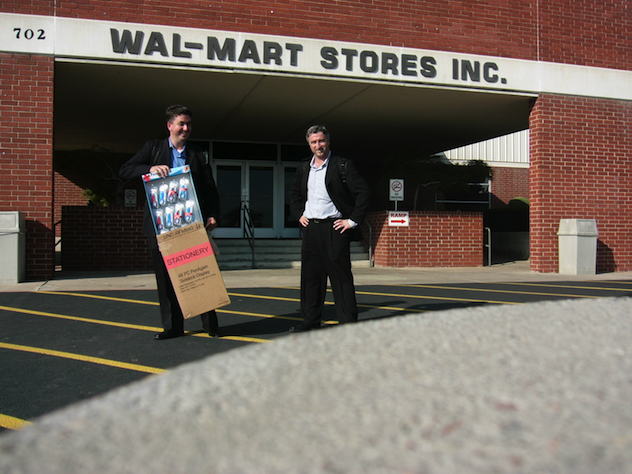
Compare Wal-Mart’s global headquarters above to the building owned and occupied by The New York Times in Manhattan:

I took a macroeconomics class a few years ago where my professor shared a documentary on Wal-Mart’s damaging impact on America. There was video footage of Wal-Mart’s supplier negotiation rooms in Bentonville that looked much like suspect interview rooms on Law and Order, sparsely appointed with uncomfortable furniture. The documentary then suggested that these spartan looking rooms with cheap folding tables and plastic chairs were intentionally designed to “sweat” suppliers into lower prices.
Maybe they have that effect, but that isn’t the intent.
The truth is, most of the cheap furniture used by Wal-Mart’s corporate offices was free, sent as samples from manufacturers and deployed into daily use. Wal-Mart’s adherence to humility and cost-cutting is so strict that it doesn’t even buy its own chairs. The head office hardly has any windows.
And Wal-Mart could have built a sprawling museum dedicated to Sam Walton’s legacy and the company’s history, but it instead uses the original Walton’s Five and Dime store in downtown Bentonville as a diminutive visitor’s center, staffed by two or three people with small exhibits and a tiny gift shop.
Unlike some of America’s large corporations, Wal-Mart doesn’t toot its own horn or use its power to intimidate the commoners. There is, after all, no Wal-Mart Tower stretching into the sky in the center of a large metropolis. There is, however, a Sears Tower, and Sears had to sell it and move to a suburban office park after only twenty years. Sears Roebuck and Co, once a retail powerhouse, was recently forced to merge with K-Mart.
With America’s history of saving and investing, Ben Franklin’s “penny saved is a penny earned” mantra, and the legacy of The Great Depression, spending less has become a virtue. Wal-Mart’s skeleton operations are indeed, by that standard, virtuous and distinctly American.
Sam Walton and his family became tremendously wealthy and combined, the Waltons are among the wealthiest people in the world. Despite becoming the richest man in the world, Sam continued living a quiet life in Arkansas, building a large, comfortable, secluded home for himself and his wife and dogs.
He continued driving this orange 1979 Ford pickup until his death in 1992.

Walton famously said in his autobiography, “Why do I drive a pickup truck? What am I supposed to haul my dogs around in, a Rolls Royce?”
Even Sam Walton’s Arkansas grave, buried in a cemetery on the same block as the company’s headquarters, is plain and undecorated, with a small stone that reads “SAMUEL MOORE.” The epitaph doesn’t say he changed the world, was a great man, was a great leader, or even the founder of Wal-Mart. He was in death as he was in life — humble and dignified.
The company was built on discipline, consistency, and seriously hard work. Even critics are compelled to acknowledge Wal-Mart’s virtues. And TWME’s author, Charles Fishman, concedes that point, and later in his book explains that Wal-Mart isn’t the faceless monster that some make it out to be. Its instead a corporation run by people with a clear mission, attempting to serve its customers above all else, trying to spread Wal-Mart’s low prices around the globe.
It isn’t that Wal-Mart intends any ill will to the public or to factory workers. Its that Wal-Mart is so unaware of itself and its impact that it causes damage without even realizing it, like a tank driving through a crowded city street, knocking over fire hydrants unintentionally.
Fishman asks that in pursuit of always low prices, perhaps Wal-Mart should acknowledge its now massive size and use its tremendous influence on markets and suppliers to save energy, improve working conditions, clean up the environment, and become a better corporate citizen.
In response to criticism, Wal-Mart now has a wide array of organic products from yogurt to baby clothes made with organic cotton, and the company has a hotline operated by a third party that allows workers all over the globe to call in and report violations (the phone number is posted on the wall at any facility that produces goods for Wal-Mart). They currently receive one call per week.
Third party firms, rather than Wal-Mart internal, are now used to check on workplace conditions and environmental standards at its suppliers, similar to the evaluation process used by Whole Foods.
Somewhere between 1992 and 2011, after the passing of Sam Walton, Wal-Mart lost some of its soul, but thanks to vocal critics (some rational and open-minded, some incurably deranged) and shareholders concerned with the company’s image, Wal-Mart is using its power to improve the lives of people around the world.
Unfortunately, toward the end of Fishman’s book, he goes into a bit of a tirade about the need for more laws, more government, and more regulations, despite acknowledging the power of information to create awareness and influence consumer and corporate behavior. Fortunately, the complaining and calls for regulation are brief while the bulk of the book focuses on Wal-Mart’s scale, its impact, and its successes and failures. An additional chapter documents Fishman’s visit to Wal-Mart HQ after the book was published and his meeting with several people including CEO Lee Scott.
Other reviews of TWME seem to suggest that the book is nothing but cheerleading for critics of Wal-Mart. It wasn’t until I flipped through it at Barnes and Noble that I discovered the depth of research and exclusive inside information, valuable to everyone from consumers to WMT shareholders to environmentalists.
A mayor in New Mexico fervently opposed the entry of Wal-Mart into his town after reading a review of “The Wal-Mart Effect,” neglecting to read the book himself. A frustrated woman at Wal-Mart HQ even asked TWME’s author, Charles Fishman, “How do I get [the mayor] to read your book?”
Based on the mayor’s reaction, I assume the review he read described the book as a scathing expose of Wal-Mart’s evildoings, and this leads me to believe that most professional book reviewers do not always read the books they review.
Whether you are a proponent or a critic, you will find something of value in this well-researched and revealing expose.
Next Saab 9-3 coupe will be nearly identical to Phoenix concept
Paul Horrell of Top Gear Magazine heads to New York to drive the Saab Phoenix concept car and learns that aside from minor changes, this will be the shape of the new 9-3 coupe.
Noteworthy quotes:
–> “Something real? Huh? A concept with scissor doors and wings like the handles of a shopping bag? “Look, even couture clothes have to fit a real human body. And this car fits a real platform. The crash structure is real, and the drivetrain, and the cooling. The packaging is real. Real people can fit inside.” Indeed they can – it’s quite accommodating in there, and you can even see out. It really does feel driveable.”
–> “Suddenly, as if remembering the rules of some PR script, he back-pedals a little. “It’s not the next 9-3 and I didn’t want this to be Photoshopped onto magazine covers as that.” OK, but a few minutes later, I’m with Saab’s chairman Victor Muller who can’t resist getting out his smartphone and showing me an image of a 9-3 coupe he’s had Castriota design. It’s basically the PhoeniX without the wings and the lower-body layering, and it really does look like a car to give the TT and RCZ pause.”
–> “Anyway, Castriota says the whole nose section of the 9-3 replacement will look just like what’son the PhoeniX. The swept-back wheel-arch modelling too. And since the PhoeniX uses Saab’s new platform, the relationship of wheels to bumper is right, including the shortened but more effective front crash structure, so Saabs won’t look as nose-heavy. “
Jason Castriota also designed the Maserati GranTurismo and Ferrari 599.
You can expect the production steering wheel to be round.
–> “Even if you don’t take your car advice from to a load of intoxicated barflies, take it from TopGear. On the strength of this car, new Saabs do deserve to see the light of day.”
Is there hope for the trolls in Trollhattan? Read on for details (its one of those annoying slide show articles):
http://www.topgear.com/uk/photos/phoenix-2011
Longer Yellow Lights, Fewer Accidents (Less Ticket Revenue)
The Missouri Department of Transportation has lengthened yellow lights at some intersections, resulting in a dramatic reduction in red light camera violations. By allowing more time for intersections to clear, opportunities for collisions are reduced.

In Arnold, Missouri, violations dropped from 709 to 17 by adding 1.5 seconds to the duration of yellow lights. Assuming fines of $100 per violation, ticket revenues decreased from $70,900 to $1,700.
Reviewed and Compared: 2007 Cadillac Escalade, Lincoln Navigator
The full-size SUV is far from dead.
The middle class woke up one morning, saw $4.50 fuel prices, and almost overnight traded in their Tahoes, Suburbans, and Expeditions for Priuses and Corollas. Unfortunately, many succumbed to panic and lost more on their trades than they would ever save in fuel.
For much of the middle class, the quadrupling of fuel prices brings with it a harsh new reality — a piece of the American dream, the joy and pleasure of piloting a mansion on wheels, has eroded. Contrary to the beliefs of environmentalists, Americans haven’t abandoned their affection for large autos, they’ve simply compromised to mitigate the effects of resource scarcity.
But those are all “poor people problems.”
For luxury buyers, fuel prices are a non-issue. A household earning $100,000 or more after taxes has more important concerns than $3000 in annual fuel costs (assuming 12,000 or fewer miles per year), which translates to a piddly $250 per month on a monthly income of over $8000. Time is arguably more scarce than crude oil, and dwelling over ways to reduce a $250 monthly fuel expense is time and energy that could otherwise be used to increase income and wealth.
Luxury car buyers, more often than not, will get what they want, and despite the ongoing economic slump, Escalade sales have remained steady since 2009 at more than 26,000 units per year. While that number is far off the mark from the 2004 peak of 62.000 units, it continues to be a highly profitable vehicle for Cadillac and General Motors. Most of the investment and development cost is absorbed among the rest of the GMT900 SUV lineup including the Yukon, Tahoe, Suburban, and Avalanche.
For 2007, the toned down, grown up Escalade moved out of the inner city and blended into the suburbs.
(2007 Escalade)
Cadillac has been intertwined with black America since the Great Depression. GM was prepared to kill the brand until a clever executive named Nicholas Dreystadt convinced GM to pursue newly affluent African Americans rather than shunning them.
From Forbes:
“Dreystadt said he had a plan to make Cadillac profitable in 18 months, Depression or no Depression. The first part of his plan resulted from an observation he had made traveling around the country to the service departments of Cadillac dealerships. Cadillac was after the prestige market, and part of its strategy to capture that market was its refusal to sell to African-Americans. Despite this official discrimination, Dreystadt had noted that an astonishing number of customers at the service departments consisted of members of the nation’s tiny African-American elite: the boxers, singers, doctors and lawyers who earned large incomes despite the flourishing Jim Crow atmosphere of the 1930s. Most status symbols were not available to these people. They couldn’t live in fancy neighborhoods or patronize fancy nightclubs. But getting around Cadillac’s policy of refusing to sell was easy: They just paid white men to front for them.
“Dreystadt urged the executive committee to go after this market. Why should a bunch of white front men get several hundred dollars each when that profit could flow to General Motors? The board bought his reasoning, and in 1934 Cadillac sales increased by 70%, and the division actually broke even. In June of 1934 Nick Dreystadt was made head of the Cadillac Division.”
The moral of the story: money transcends race.
Back in 2002 the Escalade received a bold Art and Science-themed redesign. The truck was prominently displayed in rap videos and was often driven by black athletes, actors, and musicians. A trendsetter for Cadillac, it catapulted the brand from near-death to superstardom.

(2002 Escalade)
As far as pop culture is concerned, if you were black and you “made it,” you drove an Escalade, period. As with rock music, white America followed black America’s lead, and Escalades found their way into McMansion garages all over the country.
Predating the first-generation (’99-’01) Escalade was Lincoln’s Navigator (released in 1998), which underwent a clean and conservative redesign for 2003. It failed to capture the Escalade’s cachet and bravado but served as a worthy alternative for those seeking a more refined interpretation of luxury.

(2003 Navigator)
Unfortunately, the mature and understated Navigator was often overlooked in a prosperous time where extroverted wealth was more socially acceptable. The Escalade was a better fit for the mood of America during the Bush years.
—————————————————-
Earlier this year, I went to Wichita to see a friend and got a chance to drive his 2007 Escalade.
2007 was the first year for the GMT900 SUV platform (pick-up versions debuted in 2006 as the Silverado and Sierra). GM’s current generation of full size SUVs is expected to continue production through 2014, a lengthy run partly because of lower demand for large SUVs, and mostly because of GM’s recent bankruptcy which has delayed product development.
The redesigned 2007 Escalade takes inspiration from, strangely enough, the 2003 Lincoln Navigator. With its modest use of chrome, stealthier presence, and more upscale appearance, the ultimate ghettoblaster has evolved into a posh high-end luxury cruiser. No doubt, the Escalade is larger than ever, but its level of intimidation has been dialed back significantly.
The new 2007 Navigator, meanwhile, adopted a garish front-end that looked like a last-minute afterthought.
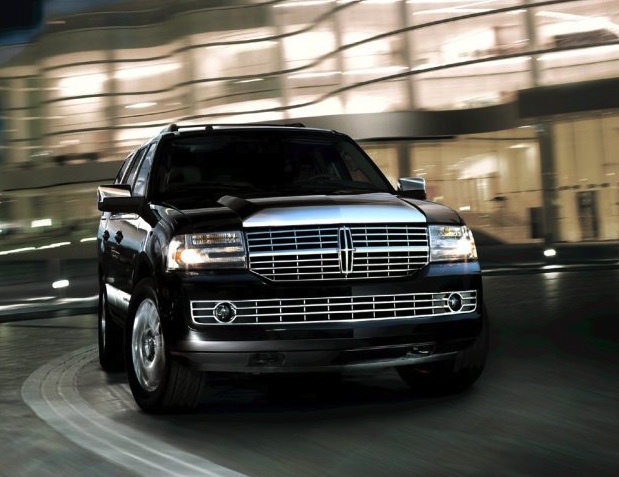
(2007 Navigator)
Lincoln claims the 1960s Continental was its inspiration. I see a closer resemblance to a sewer grate:

There’s an ongoing theme here of Lincoln and Cadillac borrowing from each other, attempting to consume each other’s share of the market.
The 2003-2006 Navigator had a steering system that was pure magic for a vehicle of its size and heft, offering ample feedback, quickness, and sharpness. The 2002-2006 Escalade, meanwhile, wandered a bit and required minor steering corrections to maintain highway accuracy.
For 2007, the Escalade’s steering system is dramatically improved, with smooth fluidity and reasonable accuracy, feeling more like a Cadillac DTS sedan than a 5700-pound house on wheels.
Braking follows the same theme. The Navigator was never equipped with excellent brakes, but it stopped with a greater sense of control than the Escalade. The ’99-’06 Escalade’s brakes felt like stepping on a plastic bag filled with thick paste, and stopping distances were in excess of 210 feet. Again, this all changes for 2007 with the Escalade adopting a revised braking system that feels reasonable, safe, and predictable. Braking distances for 2007 are down to 187 feet for according to Car and Driver. [As a point of reference, a 2006 Cadillac DTS sedan requires 178 feet.]
The Escalade also gains features previously exclusive to the Navigator including power-retractable running boards (Platinum edition) and a power liftgate.
The Navigator’s ace in the hole, one feature that retained its desirability in the market despite the Cadillac’s charisma, was its interior.
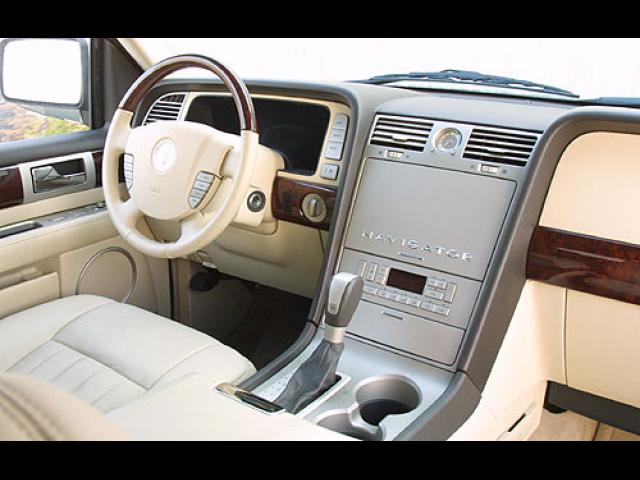
(2003 Navigator Interior)
Even with a few cheap plastics here and there, the nickel, wood, and leather-appointed ’03-’06 Navigator was a nice place to be. Unfortunately, Lincoln took a step backward in 2007 by replacing the clean and classy Optitron gauges for a garish square-themed instrument cluster inspired by Lincolns of the 1980s.

(2007 Navigator Instrument Cluster)
You get the feeling that the 2007 Navigator is desperate for attention, good or bad, like a child who acts out in school. Fortunately, the Escalade’s interior is clean and restrained:

(2007 Escalade Clock)

(2007 Escalade Passenger Seat)
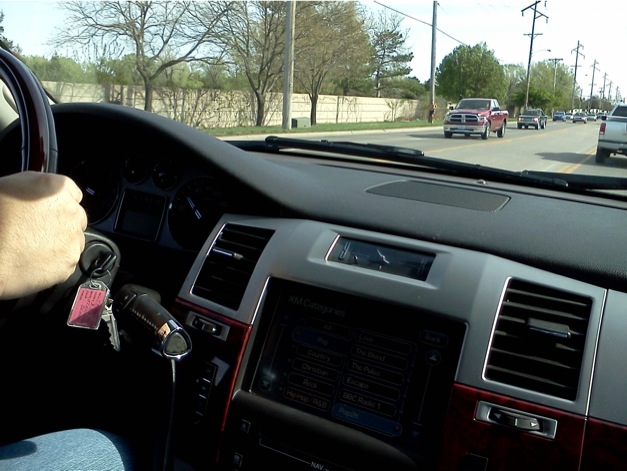
(2007 Escalade Dashboard)

(2007 Escalade Dashboard)
A tasteful combination of leather, wood, and aluminum trim look to have been inspired by the 2003-2006 Navigator. Unfortunately, some of the plastics on the dashboard, center console, and door panel feel hollow with a cheap-looking grain. Much of this was improved for the luxurious Platinum edition (not pictured).

(2007 Escalade Center Stack)
The new gauges are classier and less fussy than the cheap-looking instruments from 2002-2006:
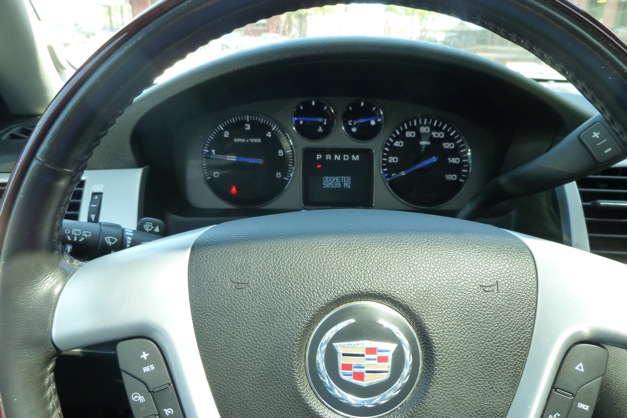
(2007 Escalade Instrument Cluster)

(2002 Escalade Instrument Cluster)
Unfortunately, the new gauges lack transmission temperature and oil pressure information. [CORRECTION: Transmission temperature can be displayed digitally by cycling through the menus. Oil pressure, however, cannot.] The numerical readouts are replaced by vague tick marks. GM’s blue fluorescent information display is mounted higher with multiple lines for better readability. The gear shift indicator’s “3 2 1” are replaced by “M”, a manual shift mode operated from the column-mounted stalk.
The entire steering wheel is surrounded by a single, uninterrupted strip of wood.

(2007 Escalade Steering Wheel)
Most luxury buyers favor the look of wood steering wheels, but the feel is unappealing. Leather breathes while polished wood does not, and this causes the hands to sweat on sunny days — sweaty hands on polished wood lead to a loss of grip. My complaint with most wood-trimmed steering wheels is the lack of a constant feel all around as most only have wood applied to the top and bottom of the wheel.
By covering the entire outside edge of the wheel with wood, the Escalade’s feel remains consistent, but for me, that makes it all-around unpleasant.

(2007 Escalade Front Door Switches)
My other complaint is the inconsistent texture and quality of the door and dashboard surfaces. The stitched leather inserts on the door panels and arm rests are beautiful, but the top part where a driver might dangle his arm is covered in cheap-looking squishy plastic. The wood and stitched leather surrounding the window switches are nice touches.
The standard GM knobs and switches offer soft tactile feedback, giving the impression of luxury. Even the headlight knob on the dashboard gets a tasteful chrome treatment.
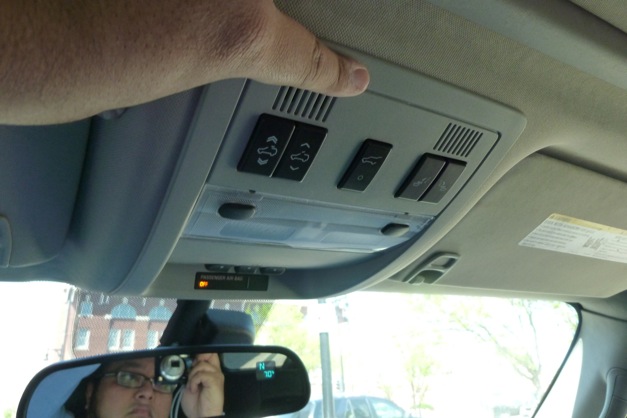
(2007 Escalade Sunroof Switches)

(2007 Escalade Second Row Seats)

(2007 Escalade Second Row Seats)
The previous owners unfortunately took this truck to the beach and often wore suntan, which caused the once-buttery black leather to take on a shiny vinyl-like appearance.

(2007 Escalade Cargo Area)
Above there’s plenty of room in the third row/cargo area. The third row seat, unlike the Navigator, does not fold flat into the floor. It folds onto itself to make room for luggage, but for maximum cargo space it must be unlatched and removed entirely.

(2007 Escalade Cargo Area)
With the third row gone, there’s lots of space for my beagle to hang out.

(2007 Escalade Infotainment System)
The 8-inch touch screen infotainment system is easy to use with a large ‘Eurostile’ font and well-organized menus. The system performs reasonably well with few delays between functions, a massive improvement over the confusing and cluttered navigation systems of the past.
XM tuning is delightfully simple with stations organized into folders by category, making it easy to navigate through hundreds of channels.
The Escalade boasts a 10-speaker 300-watt Bose discrete 5.1 surround audio system that produces plenty of deep, satisfying bass but neglects details in the highs and mids. In that regard, the system is a microcosm of the rest of the truck.

(2007 Escalade Exterior)
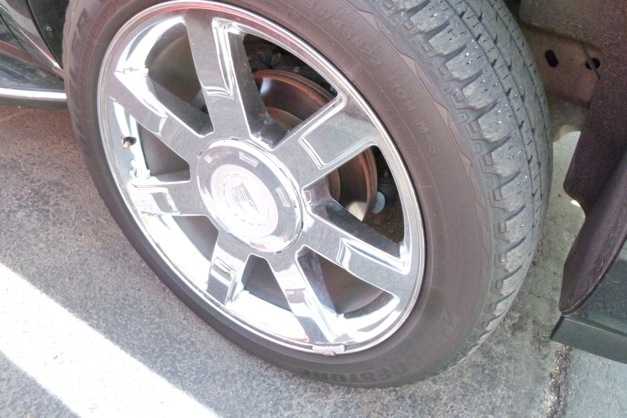
(2007 Escalade 22” OEM Wheels)

(2007 Escalade Exterior)

(2007 Escalade Exterior)
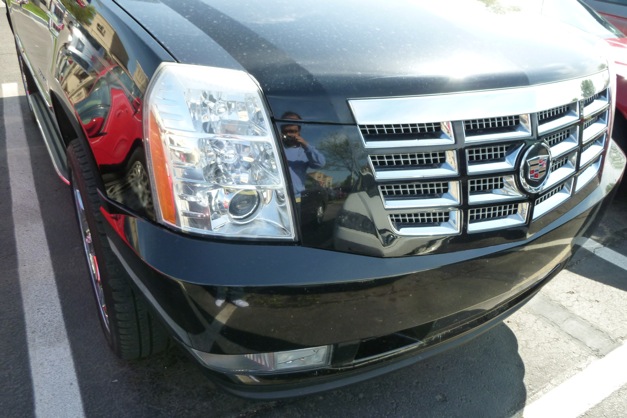
(2007 Escalade Exterior)

(2007 Escalade Exterior)
The exterior gets high marks for being tasteful and restrained, except for the vents on the fenders.
As for the paint, there is obvious orange peel on the doors and front fenders.
Arguably, the older GMT800 Escalades were built to a higher standard. Although their interiors more closely resembled downmarket Chevrolet trucks, the plastic, leather, and steel felt more substantial.
It does in fact cost General Motors less to manufacture the GMT900 trucks and SUVs, thus the reason for their accelerated release in 2006 and 2007. Still, the GMT900s are quite a bit stiffer and offer more torsional rigidity and improved handling.

(2007 Escalade Passenger Side Tail Light)
Tail lights gain a bit of Cadillac style through additional creases, a design detail intended to resemble traditional Cadillac tail fins. If you look closely, you can see that this crease extends all the way up the D-pillar:
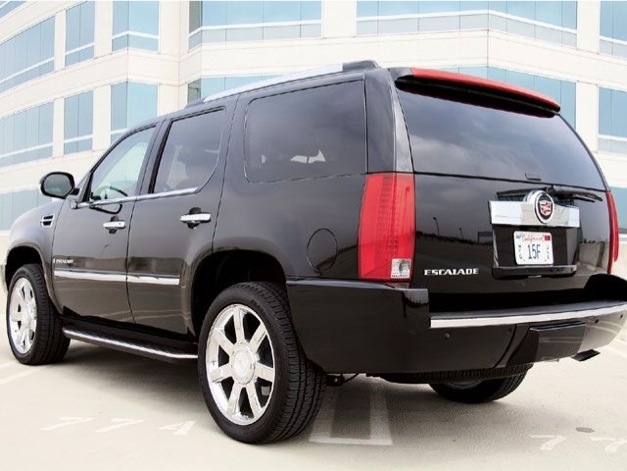
(2007 Escalade Passenger Side Tail Light)
I’ve been quite critical so far, but on a luxury truck with a sticker price that typically exceeds $70,000, the details matter.
Thankfully, a 403hp 6.2L OHV V8 produces 417 lb-ft of torque and throaty roar that would make a lion whimper. 0-60 times drop from 7.8 seconds in the previous generation to 6.5, running neck and neck (in a straight line) with some luxury sedans including the E46 BMW 330i and Lexus LS430.
Despite the numbers, full-throttle acceleration actually feels slower in the 2007 Escalade, and that’s likely due to a lack of dive and squat from the firmer suspension. The old Escalade was a marshmallow, loosely connected to the surface. The current generation is hardly what I would call taut, but it does feel much more controlled and restrained, going around corners more like a big sedan and less like an ice cream truck.
The exhaust note is intoxicating, filling the cabin with a refined roar that mimics GM cars of the 1960s (see my review of the ’64 Impala). There is little else to say about how the Escalade drives — its big, comfortable, steady, and wonderfully loud at full throttle. If you’ve driven a Cadillac DTS, imagine it being a bit faster with a higher seating position and more space.
Thanks to a six-speed automatic, highway fuel economy improves from 17 to 19 MPG for 2WD models. Unfortunately, the previous and current Escalade are both rated at 14 MPG combined by the EPA. This is a non-issue for people who buy $70,000 luxury cars, but it does matter for GM’s CAFE compliance.
The 6L80E 6-speed automatic is developing a bit of a reputation for being problematic, prone to jerks, stalls, error lights, and unexpectedly early rebuilds. If you buy used, get an extended warranty with thorough transmission coverage. This is, as far as I know, the only major issue on this truck, and it is an expensive one.
Perched on the throne of this massive three-ton urban tank, there’s a bit of guilty pleasure from dominating and brutalizing the earth below. An Escalade driver may find himself looking down (literally) at the “little people” crammed into their potato-shaped Priuses, watching them sip on every last drop of fuel like paupers savoring crumbs.
One may also enjoy the smug satisfaction of knowing that elite athletes and pop stars are cruising around in the same vehicle. While you may never get a chance to be with Charlize Theron, it’s satisfying to know that the gentleman she’s snogging probably owns an Escalade.
The allure of vanity.

(Charlize Theron)
Fast Tube by Casper
Ratings:
Ride: 10/10
This is a big Cadillac that owns the earth it rests on. The ride is compliant without being wobbly.
Powertrain: 6.7/10
Engine: 10/10 — Stump-pulling torque and a glorious exhaust note.
Transmission: 5.9/10 — Questionable reliability. Decent performance when functioning correctly.
Braking: 6.5/10
More responsive than before with more bite and less mushiness. Massive improvement over the last generation.
Steering/Handling: 6.7/10 — Hugely improved steering and well-sorted suspension. Mimics a full-size luxury sedan but a far cry from being sporty. Adequate for daily motoring.
Audio/Accessories: 9.3/10
Easy to use navigation, a large 8” display, responsive menus, and a brilliantly designed XM tuner. Sound quality is satisfying for an OEM sound system but falls short of excellent. In the Platinum edition, the Escalade enjoys more options than the Navigator Ultimate including LED headlights.
Interior: 7.9/10
A good effort. Panels are tightly fitted and well-assembled but some surfaces lack a luxury feel. Lots of unexpected details like additional stitching on the leather-wrapped column shifter, a Cadillac script logo embedded in the aluminum trim, and additional wood on the center arm rest. The climate controls are a bit low on the center stack and the third row is still the same idiotic design as before, requiring total removal to gain full cargo space.
Comfort: 10/10
Seats are wide and supportive and controls are intelligently laid out. Side bolstering is woefully inadequate, but you shouldn’t be cornering in a three-ton SUV in such a way that any side bolstering is necessary.
Styling: 8.8/10
Lacks the boldness of the previous generation but advances in leaps and bounds in terms of refinement and attention to detail. The vents on the fenders are a bit tacky as are the GM badges on the front doors. Still, everything about it says “Get the hell out of my way, I drive a Cadillac,” and that’s a good thing.
Quality/Reliability: 6.7/10
There have been reports of transmission and wind noise issues. At least it’s not a Land Rover, I guess.
Overall: 7.9/10
It will depreciate rapidly, guzzle gas, go out of style, and offend a few. But who cares? If you make a comfortable living and you want to feel like Lebron James on your commute, then buy one. However, I question the wisdom of the middle class purchasing them used.
Specifications:
Vortec 6200 V8
6.2L 16-valve aluminum OHV
Variable valve timing
Power: 403 bhp @ 5700 rpm
Torque: 417 lb-ft @ 4300 rpm
6L80E 6-speed automatic
0-60 mph: 6.5 sec
Quarter mile: 15.3 sec @ 94 mph
Braking, 70-0 mph: 200 ft
Wheelbase: 116.0 in Length: 202.5 in Width: 79.0 in Height: 74.3 in
Curb Weight: 5676 lbs
Fuel Economy:
12 city / 19 highway (2WD)
12 city / 18 highway (AWD)
Update, 7/23/2011:
I met up with two friends in Wichita, Kansas and traveled in the Escalade to San Antonio, Texas, about 630 miles one way. Sprawled across the second row, I indulged in living room-like space and comfort and was even able to lay across and take a nap.
Rear seat passengers are treated to a full suite of audio and climate controls along with two headphone jacks with separate volume knobs. The rear seat passenger cannot tune XM stations independently from the front because of only one satellite tuner available on board, but AM and FM reception are stellar with clear static-free audio over long distances. Vents in the ceiling, a broad selection of rear climate controls, and a powerful blower motor provide back seat passengers with exceptional comfort.
Unfortunately, I have one gripe, and that’s wind noise. There are several theories behind the cause including door alignment, glass alignment, and rubber seals. 2007 models appear to be the primary vehicles affected. One theory is that because of a robot failure, UAW workers were used to install glass which resulted in inconsistencies. Some say its a design and engineering flaw, and a few customers have had their vehicles replaced by GM under their state’s vehicle lemon laws.
Whatever it is, going down the road at 80 MPH gives the impression that a door isn’t closed all the way or a window is cracked open. It isn’t nearly as loud as my aging Saab convertible (which is reasonably quiet for a 21 year-old ragtop) but in a cavernous SUV that’s free of road and engine noise, the howl of the wind becomes annoyingly apparent.
My advice is to test drive the truck at Texas highway speeds with the radio off and a piece of duct tape over the salesman’s mouth before making a purchase.





